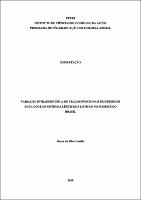| ???jsp.display-item.social.title??? |


|
Please use this identifier to cite or link to this item:
https://tede.ufrrj.br/jspui/handle/jspui/4764| ???metadata.dc.type???: | Dissertação |
| Title: | Variação intraespecífica de traços funcionais em peixes de água doce de sistemas lênticos e lóticos do Sudeste do Brasil |
| Other Titles: | Intraspecific variation of functional traits in freshwater fish from lentic and lotic systems in Southeast Brazil |
| ???metadata.dc.creator???: | Camilo, Geysa da Silva  |
| ???metadata.dc.contributor.advisor1???: | Araújo, Francisco Gerson |
| First advisor-co: | Terra, Bianca de Freitas |
| ???metadata.dc.contributor.referee1???: | Albrecht, Miriam Pilz |
| ???metadata.dc.contributor.referee2???: | Pinto, Benjamim Carvalho Teixeira |
| ???metadata.dc.contributor.referee3???: | Queiroz, Jarbas Marçal |
| ???metadata.dc.description.resumo???: | A variação intraespecífica reflete diferenças entre características de organismos de uma mesma população, sendo um dos aspectos mais importantes das teorias evolutivas e ecológicas. O objetivo deste estudo foi investigar a magnitude e direção da variação intraespecífica de peixes entre diferentes tipos de ambientes de águas interiores (lênticos e lóticos) no Sudeste do Brasil. Para isso, 20 características funcionais foram medidas e analisadas em 10 indivíduos de seis espécies em cada ambiente (rios e reservatórios). A hipótese testada é de que a variação intraespecífica seria maior nos ambientes lóticos, uma vez que se espera maior variação nos traços de espécies em ambientes heterogêneos e com maior disponibilidade de habitats. De acordo com o coeficiente de variação intraespecífica calculado para cada espécie separadamente, a variação intraespecífica foi maior nos ambientes lênticos, contrariando nossa hipótese inicial. De acordo com a Análise de Covariância utilizada para testar o efeito dos ambientes lênticos e lóticos em cada espécie, removendo o efeito do tamanho, as características abertura da boca, altura do corpo, largura do corpo e comprimento do intestino foram as que com maior frequência diferiram significativamente entre os ambientes lênticos e lóticos, sendo frequentemente maiores nos ambientes lênticos. Tanto para os ambientes lóticos, como para os ambientes lênticos, as características abertura da boca, altura da nadadeira peitoral, comprimento do intestino, diâmetro do ovócito, número de ovócitos e índice gonadossomático tiveram maior variação à nível intraespecífico (Variação Intraespecífica Relativa > 60%), enquanto as características diâmetro do olho, comprimento da nadadeira pélvica e comprimento da nadadeira dorsal variaram mais à nível interespecífico (Variação Intraespecífica Relativa < 25%). Muitas características apresentaram baixa variação intraespecífica relativa em ambos os tipos de ambientes e por isso são melhores para ser associadas com as características ambientais. |
| Abstract: | The intraspecific variation reflects differences in characteristics of the organisms in a given population, and is one of the most important aspects of evolutionary and ecological theories. The aim of this study was to investigate the magnitude and direction of intraspecific variation in fish species between two different types of aquatic systems (lentic and lotic) in Southeast Brazil. Twenty functional characteristics were measured and analyzed in 10 individuals of six species in each system (reservoirs and rivers). The tested hypothesis is that intraspecific variation would be greater in lotic environments because we expect greater variation in species traits of individuals in heterogeneous systems with greater habitat availability. According to the intraspecific coefficient of variation for each trait in each species, intraspecific variation was higher in lentic systems, which is contrary to our initial hypothesis. According to the Analysis of Covariance to test the effect of the lentic and lotic systems in each species, removing the size effect, the traits oral gape, body depth, body width and gut length were those that most differed significantly between the lentic and lotic environments, being frequently greater in the lentic systems. For both lotic and lentic systems, the traits oral gape, pectoral fin height, gut length, oocyte diameter, oocyte number and gonadosomatic index had greater variation at the intraspecific level (Relative Intraespecific Variation > 60% ), whereas the traits eye diameter, pelvic fin length and dorsal fin length varied more at the interspecific level (Relative Intraspecific Variation < 25%). The traits eye diameter, eye position, body width, pectoral fin length, pelvic fin height and length, caudal fin height and length, dorsal fin height and length, anal fin height, and gill raker length had low relative intraspecific variation in both systems and therefore are better to be associated with environmental characteristics. |
| Keywords: | Características funcionais Reservatórios Rios Functional traits Reservoirs Rivers |
| ???metadata.dc.subject.cnpq???: | Ecologia |
| Language: | por |
| ???metadata.dc.publisher.country???: | Brasil |
| Publisher: | Universidade Federal Rural do Rio de Janeiro |
| ???metadata.dc.publisher.initials???: | UFRRJ |
| ???metadata.dc.publisher.department???: | Instituto de Ciências Biológicas e da Saúde |
| ???metadata.dc.publisher.program???: | Programa de Pós-Graduação em Biologia Animal |
| Citation: | CAMILO, Geysa da Silva. Variação intraespecífica de traços funcionais em peixes de água doce de sistemas lênticos e lóticos do Sudeste do Brasil. 2018. 49 f. Dissertação (Mestrado em Biologia Animal) - Instituto de Ciências Biológicas e da Saúde, Departamento de Biologia Animal, Universidade Federal Rural do Rio de Janeiro, Seropédica - RJ, 2018. |
| ???metadata.dc.rights???: | Acesso Aberto |
| URI: | https://tede.ufrrj.br/jspui/handle/jspui/4764 |
| Issue Date: | 31-Aug-2018 |
| Appears in Collections: | Mestrado em Biologia Animal |
Files in This Item:
| File | Description | Size | Format | |
|---|---|---|---|---|
| 2018 - Geysa da Silva Camilo.pdf | 2.98 MB | Adobe PDF |  Download/Open Preview |
Items in DSpace are protected by copyright, with all rights reserved, unless otherwise indicated.




